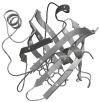The role of salivary lipocalins in blood feeding by Rhodnius prolixus
- PMID: 15660358
- PMCID: PMC2915583
- DOI: 10.1002/arch.20032
The role of salivary lipocalins in blood feeding by Rhodnius prolixus
Abstract
In order to overcome host mechanisms that prevent blood loss, the blood-sucking bug Rhodnius prolixus has evolved a complex salivary secretion containing dozens of different proteins. A number of these have been characterized and found to have roles in inhibiting various hemostatic or inflammatory systems. Interestingly, many of these biologically active salivary proteins belong to the lipocalin protein family. A proliferation of lipocalin genes has occurred via gene duplication and subsequent divergence. Functional genomic, proteomic, and functional studies have been performed to probe the role of salivary lipocalins in blood feeding. In the course of these investigations, anticoagulant, antiplatelet, antiinflammatory, and vasodilatory molecules have been described.
Published 2005 Wiley-Liss, Inc.
Figures


Similar articles
-
Exploring the sialome of the blood-sucking bug Rhodnius prolixus.Insect Biochem Mol Biol. 2004 Jan;34(1):61-79. doi: 10.1016/j.ibmb.2003.09.004. Insect Biochem Mol Biol. 2004. PMID: 14976983
-
Nitrophorins and related antihemostatic lipocalins from Rhodnius prolixus and other blood-sucking arthropods.Biochim Biophys Acta. 2000 Oct 18;1482(1-2):110-8. doi: 10.1016/s0167-4838(00)00165-5. Biochim Biophys Acta. 2000. PMID: 11058753 Review.
-
Purification and characterization of prolixin S (nitrophorin 2), the salivary anticoagulant of the blood-sucking bug Rhodnius prolixus.Biochem J. 1995 May 15;308 ( Pt 1)(Pt 1):243-9. doi: 10.1042/bj3080243. Biochem J. 1995. PMID: 7755571 Free PMC article.
-
Purification, cloning, expression, and mechanism of action of a novel platelet aggregation inhibitor from the salivary gland of the blood-sucking bug, Rhodnius prolixus.J Biol Chem. 2000 Apr 28;275(17):12639-50. doi: 10.1074/jbc.275.17.12639. J Biol Chem. 2000. PMID: 10777556
-
An updated catalog of lipocalins of the chagas disease vector Rhodnius prolixus (Hemiptera, Reduviidae).Insect Biochem Mol Biol. 2022 Jul;146:103797. doi: 10.1016/j.ibmb.2022.103797. Epub 2022 May 28. Insect Biochem Mol Biol. 2022. PMID: 35640811 Review.
Cited by
-
Anti-inflammatory and immunomodulatory effects of Ulomoides dermestoides on induced pleurisy in rats and lymphoproliferation in vitro.Inflammation. 2010 Jun;33(3):173-9. doi: 10.1007/s10753-009-9171-x. Inflammation. 2010. PMID: 20020191
-
NMR studies of the dynamics of nitrophorin 2 bound to nitric oxide.Biochemistry. 2013 Nov 12;52(45):7910-25. doi: 10.1021/bi4010396. Epub 2013 Oct 30. Biochemistry. 2013. PMID: 24116947 Free PMC article.
-
Venoms of Heteropteran Insects: A Treasure Trove of Diverse Pharmacological Toolkits.Toxins (Basel). 2016 Feb 12;8(2):43. doi: 10.3390/toxins8020043. Toxins (Basel). 2016. PMID: 26907342 Free PMC article. Review.
-
The "Vampirome": Transcriptome and proteome analysis of the principal and accessory submaxillary glands of the vampire bat Desmodus rotundus, a vector of human rabies.J Proteomics. 2013 Apr 26;82:288-319. doi: 10.1016/j.jprot.2013.01.009. Epub 2013 Feb 11. J Proteomics. 2013. PMID: 23411029 Free PMC article.
-
The role of saliva in tick feeding.Front Biosci (Landmark Ed). 2009 Jan 1;14(6):2051-88. doi: 10.2741/3363. Front Biosci (Landmark Ed). 2009. PMID: 19273185 Free PMC article. Review.
References
-
- Andersen JF, Champagne DE, Weichsel A, Ribeiro JMC, Balfour CA, Dress V, Montfort WR. Nitric Oxide Binding and Crystallization of Recombinant Nitrophorin I, a Nitric Oxide Transport Protein from the Blood-Sucking Bug Rhodnius prolixus. Biochemistry. 1997;36(15):4423–4428. - PubMed
-
- Andersen JF, Ding XD, Balfour C, Shokhireva TK, Champagne DE, Walker FA, Montfort WR. Kinetics and equilibria in ligand binding by nitrophorins 1–4: Evidence for stabilization of a nitric oxide-ferriheme complex through a lignad-induced conformational trap. Biochemistry. 2000;39(33):10118–10131. - PubMed
-
- Andersen JF, Francischetti IMB, Valenzuela JG, Schuck P, Ribeiro JMC. Inhibition of hemostasis by a high affinity biogenic amine-binding protein from the saliva of a blood-feeding insect. J Biol Chem. 2003;278:4611–4617. - PubMed
-
- Andersen JF, Montfort WR. The crystal structure of nitrophorin 2: A trifunctional antihemostatic protein form the saliva of Rhodnius prolixus. J Biol Chem. 2000;275(39):30496–30503. - PubMed
Publication types
MeSH terms
Substances
Grants and funding
LinkOut - more resources
Full Text Sources
Medical

